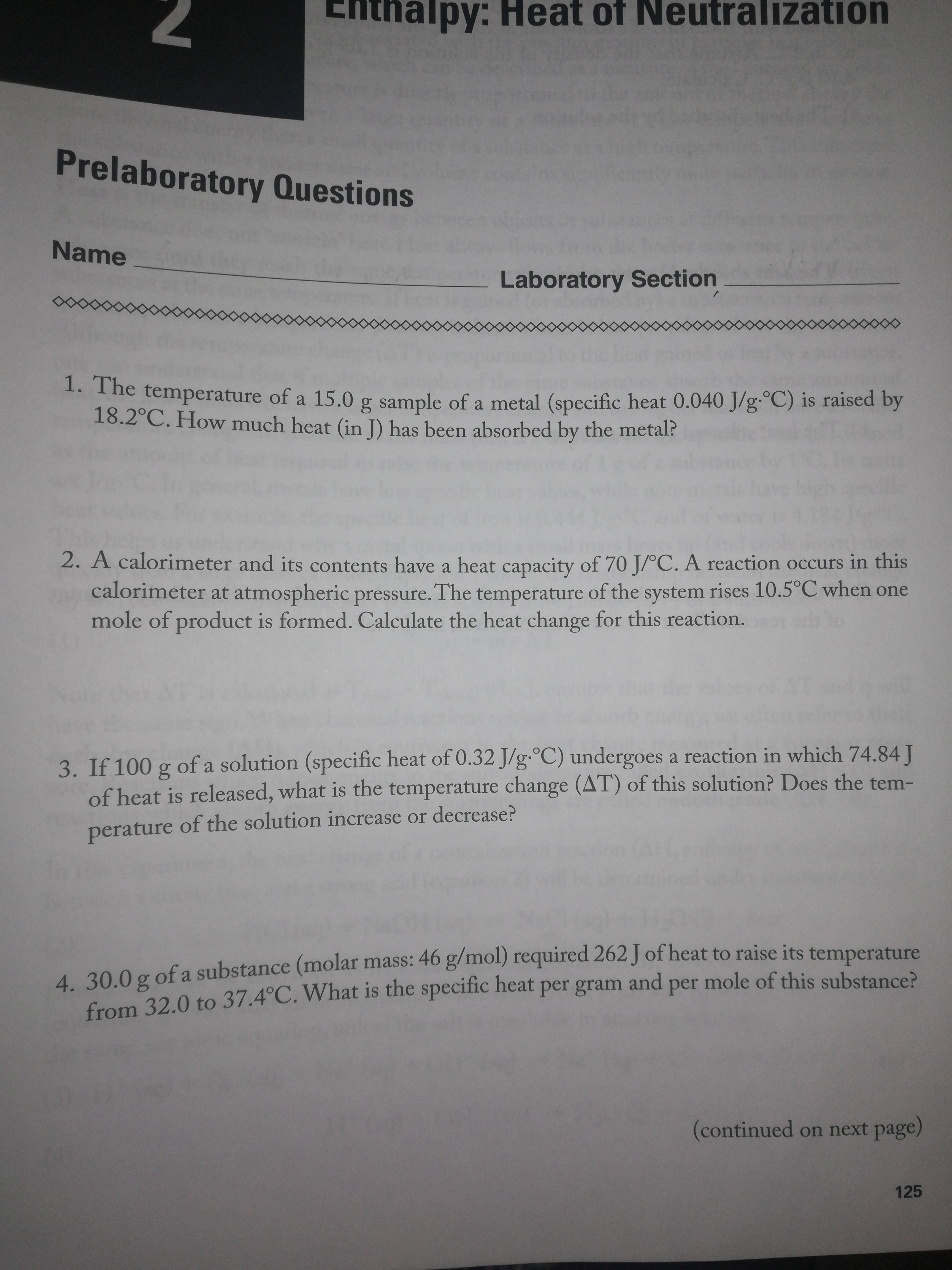alpy: Heat of Neutralızation Prelaboratory Questions Name Laboratory Section 1. The The temperature 18.2°C. How much heat (in ) has been absorbed by the metal? of a 15.0 g sample of a metal (specific heat 0.040 J/g-°C) is raised by 2. A calorimeter and its contents have a heat capacity of 70 J/°C. A reaction occurs in this calorimeter at atmospheric pressure. The temperature of the system rises 10.5°C when one mole of product is formed. Calculate the heat change for this reaction. o 3. If 100 g of a solution (specific heat of 0.32 J/g-°C) undergoes a reaction in which 74.84 J of heat is released, what is the temperature change (AT) of this solution? Does the tem- perature of the solution increase or decrease? 4 30.0 g of a substance (molar mass: 46 g/mol) required 262J of heat to raise its temperature from 32.0 to 37.4°C. What is the specific heat per gram and per mole of this substance? (continued on next page) 125
alpy: Heat of Neutralızation Prelaboratory Questions Name Laboratory Section 1. The The temperature 18.2°C. How much heat (in ) has been absorbed by the metal? of a 15.0 g sample of a metal (specific heat 0.040 J/g-°C) is raised by 2. A calorimeter and its contents have a heat capacity of 70 J/°C. A reaction occurs in this calorimeter at atmospheric pressure. The temperature of the system rises 10.5°C when one mole of product is formed. Calculate the heat change for this reaction. o 3. If 100 g of a solution (specific heat of 0.32 J/g-°C) undergoes a reaction in which 74.84 J of heat is released, what is the temperature change (AT) of this solution? Does the tem- perature of the solution increase or decrease? 4 30.0 g of a substance (molar mass: 46 g/mol) required 262J of heat to raise its temperature from 32.0 to 37.4°C. What is the specific heat per gram and per mole of this substance? (continued on next page) 125
Introductory Chemistry: A Foundation
9th Edition
ISBN:9781337399425
Author:Steven S. Zumdahl, Donald J. DeCoste
Publisher:Steven S. Zumdahl, Donald J. DeCoste
Chapter10: Energy
Section: Chapter Questions
Problem 44QAP: When ethanol (grain alcohol, is burned in oxygen, approximately 1360 kJ of heat energy is released...
Related questions
Question
2

Transcribed Image Text:alpy: Heat of Neutralızation
Prelaboratory Questions
Name
Laboratory Section
1. The
The temperature
18.2°C. How much heat (in ) has been absorbed by the metal?
of a 15.0 g sample of a metal (specific heat 0.040 J/g-°C) is raised by
2. A calorimeter and its contents have a heat capacity of 70 J/°C. A reaction occurs in this
calorimeter at atmospheric pressure. The temperature of the system rises 10.5°C when one
mole of product is formed. Calculate the heat change for this reaction. o
3. If 100 g of a solution (specific heat of 0.32 J/g-°C) undergoes a reaction in which 74.84 J
of heat is released, what is the temperature change (AT) of this solution? Does the tem-
perature of the solution increase or decrease?
4 30.0 g of a substance (molar mass: 46 g/mol) required 262J of heat to raise its temperature
from 32.0 to 37.4°C. What is the specific heat per gram and per mole of this substance?
(continued on next page)
125
Expert Solution
This question has been solved!
Explore an expertly crafted, step-by-step solution for a thorough understanding of key concepts.
This is a popular solution!
Trending now
This is a popular solution!
Step by step
Solved in 5 steps with 2 images

Knowledge Booster
Learn more about
Need a deep-dive on the concept behind this application? Look no further. Learn more about this topic, chemistry and related others by exploring similar questions and additional content below.Recommended textbooks for you

Introductory Chemistry: A Foundation
Chemistry
ISBN:
9781337399425
Author:
Steven S. Zumdahl, Donald J. DeCoste
Publisher:
Cengage Learning

Chemistry: An Atoms First Approach
Chemistry
ISBN:
9781305079243
Author:
Steven S. Zumdahl, Susan A. Zumdahl
Publisher:
Cengage Learning

Chemistry: Principles and Reactions
Chemistry
ISBN:
9781305079373
Author:
William L. Masterton, Cecile N. Hurley
Publisher:
Cengage Learning

Introductory Chemistry: A Foundation
Chemistry
ISBN:
9781337399425
Author:
Steven S. Zumdahl, Donald J. DeCoste
Publisher:
Cengage Learning

Chemistry: An Atoms First Approach
Chemistry
ISBN:
9781305079243
Author:
Steven S. Zumdahl, Susan A. Zumdahl
Publisher:
Cengage Learning

Chemistry: Principles and Reactions
Chemistry
ISBN:
9781305079373
Author:
William L. Masterton, Cecile N. Hurley
Publisher:
Cengage Learning

Chemistry by OpenStax (2015-05-04)
Chemistry
ISBN:
9781938168390
Author:
Klaus Theopold, Richard H Langley, Paul Flowers, William R. Robinson, Mark Blaser
Publisher:
OpenStax


Chemistry
Chemistry
ISBN:
9781305957404
Author:
Steven S. Zumdahl, Susan A. Zumdahl, Donald J. DeCoste
Publisher:
Cengage Learning